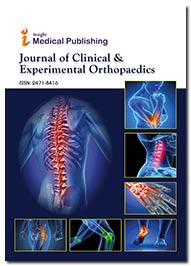Biomechanical Insights into Anterior Cruciate Ligament (ACL) Reconstruction Techniques
Sofia Alvarez
Department of Traumatology and Orthopaedics, University of Barcelona, Barcelona, Spain
Published Date: 2025-02-28DOI10.36648/2471-8416.11.1.319
Sofia Alvarez*
Department of Traumatology and Orthopaedics, University of Barcelona, Barcelona, Spain
Corresponding author:
Sofia Alvarez,
Department of Traumatology and Orthopaedics, University of Barcelona, Barcelona, Spain,
E-mail: sofia.alvez@use.es
Received date: February 03, 2025, Manuscript No. ipjceop-25-20803; Editor assigned date: August 05, 2025, PreQC No. ipjceop-25-20803 (PQ); Reviewed date: August 17, 2025, QC No. ipjceop-25-20803; Revised date: August 22, 2025, Manuscript No. ipjceop-25-20803 (R); Published date: August 28, 2025, DOI: 10.36648/2471-8416.11.1.319
Citation: Alvarez S (2025) Biomechanical Insights into Anterior Cruciate Ligament (ACL) Reconstruction Techniques. J Clin Exp Orthopr Vol.11 No.1: 319.
Introduction
The anterior cruciate ligament is a key stabilizer of the knee joint, preventing anterior tibial translation and rotational instability. ACL injuries are among the most common ligamentous injuries in athletes and physically active populations, often requiring surgical reconstruction for restoration of knee stability and function. Over the decades, numerous surgical techniques and graft options have been developed. A biomechanical perspective is essential to evaluate their effectiveness, as the ultimate goal of ACL reconstruction is to replicate native ligament kinematics and load-bearing properties. The native ACL is composed of two functional bundlesâ??the anteromedial and posterolateral bundlesâ??that provide stability across different ranges of motion. This anatomical complexity makes reconstruction challenging. Traditional single-bundle reconstructions aim to replicate the AM bundle, while double-bundle techniques attempt to restore both AM and PL bundles. Biomechanical studies comparing these approaches have provided critical insights into their relative strengths and limitations [1].
Description
Single-bundle ACL reconstruction remains the most commonly performed technique. It primarily restores anterior stability by reconstructing the AM bundle. While clinical outcomes are generally favorable, biomechanical studies have shown that single-bundle techniques may not fully restore rotational stability, particularly in activities involving pivoting and cutting. This limitation has driven the exploration of double-bundle and anatomical reconstruction strategies. Double-bundle reconstruction attempts to replicate both bundles of the native ACL, providing a more anatomic restoration of knee kinematics. Biomechanical evidence suggests that double-bundle techniques offer superior control of both anterior tibial translation and rotational stability compared to single-bundle procedures. However, they are technically demanding, require additional tunnels, and may increase the risk of complications such as tunnel convergence and graft failure [2].
The choice of graft material also plays a central role in biomechanical performance. Autografts, such as hamstring tendon and boneâ??patellar tendonâ??bone, are widely used. BPTB grafts demonstrate superior fixation strength and bone-to-bone healing, making them biomechanically robust, particularly under high loads. Hamstring grafts, on the other hand, provide excellent tensile strength but rely on soft tissue-to-bone healing, which may prolong biological incorporation. In recent years, allografts and synthetic grafts have been introduced as alternatives. While they reduce donor site morbidity and shorten operative time, biomechanical studies indicate that allografts often exhibit inferior strength and delayed incorporation compared to autografts. Synthetic grafts, although promising in tensile properties, have shown variable clinical outcomes due to issues such as graft rupture and inflammatory responses [3].
Tunnel placement is another critical biomechanical factor. Non-anatomic tunnel positioning can lead to altered graft forces, impaired stability, and premature failure. Advances in imaging and surgical navigation have emphasized anatomic tunnel placement, where grafts are positioned within the native ACL footprint. Biomechanical testing confirms that anatomic reconstructions more accurately replicate the native ligamentâ??s load-sharing capacity and kinematics [4].
Fixation techniques also influence reconstruction biomechanics. Interference screws, cortical buttons, and cross-pins each affect initial fixation strength, graft slippage, and biological healing. Studies suggest that fixation close to the joint line, such as with interference screws in BPTB grafts, provides superior biomechanical stability compared to more distant fixation methods. Optimizing fixation methods remains essential for early rehabilitation and long-term graft survival. Another emerging area is augmentation techniques, such as using suture tape or internal bracing to reinforce the graft. These adjuncts reduce graft strain during high-load activities and may accelerate return to sport by allowing earlier loading. Biomechanical evaluations support their role in reducing graft elongation and protecting against early failure [5].
Conclusion
Biomechanical insights have greatly advanced the understanding and refinement of ACL reconstruction techniques. Single-bundle reconstructions remain effective for restoring anterior stability, while double-bundle and anatomic techniques provide improved rotational control. Graft selection, tunnel positioning, and fixation methods all significantly influence biomechanical outcomes, and emerging technologies such as graft augmentation and surgical navigation continue to optimize results. Although current methods approximate native ligament function, further integration of biomechanics, tissue engineering, and personalized surgery is needed to achieve true restoration of ACL anatomy and performance. Ultimately, biomechanical research remains the cornerstone for improving surgical strategies, enhancing patient recovery, and reducing the risk of reinjury.
Acknowledgement
None.
Conflict of Interest
None.
References
- Nguyen JC, Guariento A, Nicholson A, Nguyen MK, Gendler L, et al. (2021). Hand bone age radiography: Comparison between slot-scanning and conventional techniques. J Pediatr Orthop41: e167-e173.
Google Scholar Cross Ref Indexed at
- Dekker TJ, Rush JK, Schmitz MR. (2018). What’s new in pediatric and adolescent anterior cruciate ligament injuries?. J Pediatr Orthop38: 185-192.
Google Scholar Cross Ref Indexed at
- Kocher MS, Heyworth BE, Fabricant PD, Tepolt FA, Micheli LJ (2018). Outcomes of physeal-sparing ACL reconstruction with iliotibial band autograft in skeletally immature prepubescent children. JBJS100: 1087-1094.
Google Scholar Cross Ref Indexed at
- Anderson CN, Anderson AF. (2017). Management of the anterior cruciate ligament–injured knee in the skeletally immature athlete. Clin Sports Med36: 35-52.
Google Scholar Cross Ref Indexed at
- Shaw L, Finch CF. (2017). Trends in pediatric and adolescent anterior cruciate ligament injuries in Victoria, Australia 2005–2015. Int J Environ Res Public Health14: 599.
Open Access Journals
- Aquaculture & Veterinary Science
- Chemistry & Chemical Sciences
- Clinical Sciences
- Engineering
- General Science
- Genetics & Molecular Biology
- Health Care & Nursing
- Immunology & Microbiology
- Materials Science
- Mathematics & Physics
- Medical Sciences
- Neurology & Psychiatry
- Oncology & Cancer Science
- Pharmaceutical Sciences
